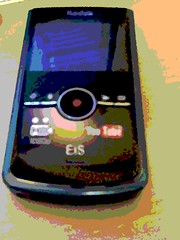Lights, Camera, Inaction: A Personal View of Kodak Technology
Look, I don’t wish to overstate the case, but yesterday I really understood, on a deep level, where Albert King was coming from when he wrote that great blues line, “If it wasn’t for bad luck, I wouldn’t have no luck at all.” Because yesterday was the day that my beloved Kodak Zi8 pocket camcorder suddenly died. Admittedly, that was the only bad thing that has happened for a while, not everything like the lyric I just quoted suggests, but even so….
 It’s almost as if the Zi8, seeing what happened to its creator, decided to give up the ghost. Just a couple of days ago Kodak filed for bankruptcy, only about a week after The Economist predicted its demise in an article called The last Kodak moment? What happened to Kodak was sad, and a lesson to businesses everywhere: it just didn’t act or even react quickly enough when photography started to become digital. True, it did produce the first digital camera, but somehow seemed not to fully realise it was a complete game-changer. A great shame, because in its day Kodak put photography into the hands of ordinary people. Its great triumph was to make the technology not only affordable, but easy to use. Had it made inexpensive stuff that was hard to make sense of, it would never have succeeded the way it did.
It’s almost as if the Zi8, seeing what happened to its creator, decided to give up the ghost. Just a couple of days ago Kodak filed for bankruptcy, only about a week after The Economist predicted its demise in an article called The last Kodak moment? What happened to Kodak was sad, and a lesson to businesses everywhere: it just didn’t act or even react quickly enough when photography started to become digital. True, it did produce the first digital camera, but somehow seemed not to fully realise it was a complete game-changer. A great shame, because in its day Kodak put photography into the hands of ordinary people. Its great triumph was to make the technology not only affordable, but easy to use. Had it made inexpensive stuff that was hard to make sense of, it would never have succeeded the way it did.
My first experience of this was taking photos with my mother’s Box Brownie. As I recall, this was incredibly easy to use. The most difficult aspects of using it were inserting the film and then removing the film without exposing it to the light. (My mum could do this with the camera and her hands inside a dark bag.) The model she had just required you to make one decision: whether to use the flash or not. Apart from that, the only thing you needed to do was press the button.
The first Kodak camera I owned in my own right was a Kodak Instamatic. That was even easier to use than the Box Brownie, because the film came in a cartridge that you could insert or take out in broad daylight. The model I had made you feel like a real photographer because it put important decisions into the hands of the user – namely, deciding whether it was sunny or cloudy.
Later, I became addicted to cinematography, and embraced the new Kodak Super 8 format. Like the Instamatic film, this came in a cartridge rather than on a roll. There were inherent advantages in the film over the prevailing amateur standard of what was to become known as Standard 8, but the key thing, I think, was the cartridge. Being able to snap a cartridge of film in and out of the camera made cinematography less geeky, more accessible. Having said that, I loved what you might call the “geeky aspects” of film-making – the editing (which in those days involved splicing, or cutting, the film and joining bits of film together), titling, and creating special effects (my still favourite one being the film I made of my sister seeming to regurgitate a banana from her mouth back into its skin. Disgusting but effective! And before you criticise, I was only 15 at the time and generally a thoroughly decent person.)
So strongly was Kodak identified with photography in the minds of everyday people, that when, as a boy of 14, I decided I’d like to see how film is processed I naturally thought of visiting the Kodak factory just outside London. I wrote to them and arranged a guided tour for myself and around half a dozen friends.
But this post isn’t simply a nostalgic trip down memory lane. I think there is one really important and obvious point that anyone whose work involves encouraging others to engage with technology must recognise: Kodak succeeded because it made the technology accessible, and made it possible for anyone to enjoy the benefits of the technology without having to understand it or even do very much with it. That sort of thing may upset some purists, but if it does, well that’s their problem. Kodak recognised, in effect, what I came to call (so modestly) Freedman’s 5 Minute Rule, and what all clever technology companies have worked out: for technology to be adopted it has to meet a need and be easy to use well. In other words, people need to be able to get great results without even understanding how it works.
